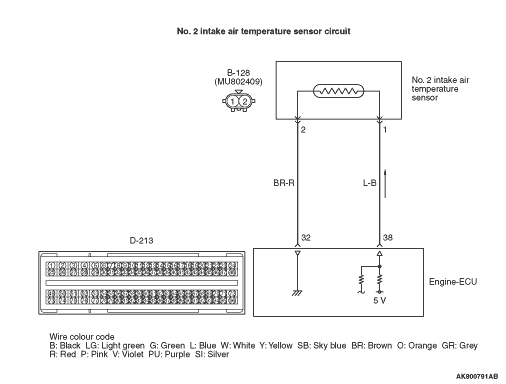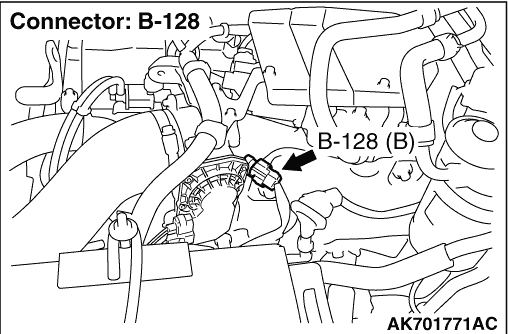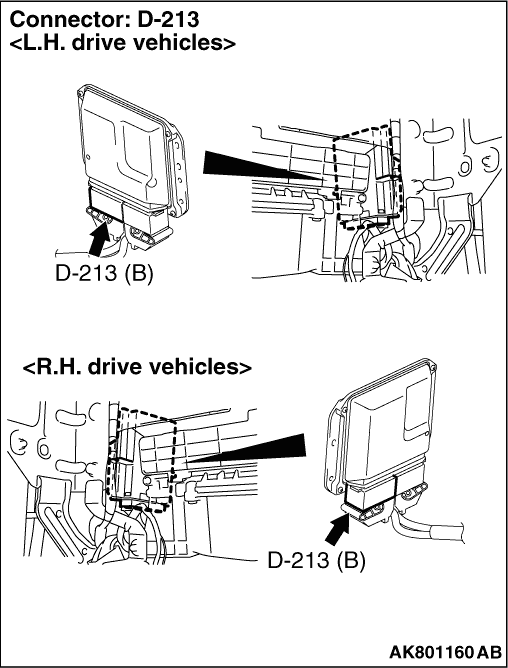|
|
- Item 8: No. 2 intake air temperature sensor
|
|
|
OK: At ambient temperature (atmospheric temperature) or equivalent.
|
|
|
Q.
Is the check result normal?
|
|
|
 Intermittent malfunction (Refer to GROUP 00 - How to Use Troubleshooting/Inspection
Service Points - How to Cope with Intermittent Malfunctions Intermittent malfunction (Refer to GROUP 00 - How to Use Troubleshooting/Inspection
Service Points - How to Cope with Intermittent Malfunctions  ). ).
|
|
|
|
|
|
Q.
Is the check result normal?
|
|
|
 Repair or replace the connector. Repair or replace the connector.
|
|
|
|
|
|
- Check No. 2 intake air temperature sensor itself (Refer to
 ). ).
|
|
|
Q.
Is the check result normal?
|
|
|
 Replace the No. 2 intake air temperature sensor. Replace the No. 2 intake air temperature sensor.
|
|
|
|
|
|
- Disconnect connector, and measure at harness side.
- Ignition switch: ON
- Voltage between terminal No. 1 and earth.
|
|
|
Q.
Is the check result normal?
|
|
|
Q.
Is the check result normal?
|
|
|
 Repair or replace the connector. Repair or replace the connector.
|
|
|
|
|
|
- Check output line for open circuit.
|
|
|
Q.
Is the check result normal?
|
|
|
 Repair the damaged harness wire. Repair the damaged harness wire.
|
|
|
|
|
|
- Item 8: No. 2 intake air temperature sensor
|
|
|
OK: At ambient temperature (atmospheric temperature) or equivalent.
|
|
|
Q.
Is the check result normal?
|
|
|
 Intermittent malfunction (Refer to GROUP 00 - How to Use Troubleshooting/Inspection
Service Points - How to Cope with Intermittent Malfunctions Intermittent malfunction (Refer to GROUP 00 - How to Use Troubleshooting/Inspection
Service Points - How to Cope with Intermittent Malfunctions  ). ).
|
|
|
|
|
|
 Replace the engine-ECU. When the engine-ECU is replaced, write the chassis number
(Refer to GROUP 00 - Precautions Before Service - How to Perform Chassis Number
Writing Replace the engine-ECU. When the engine-ECU is replaced, write the chassis number
(Refer to GROUP 00 - Precautions Before Service - How to Perform Chassis Number
Writing  ). After replacing the engine-ECU, register the injector
identification code and learn fuel injection (Refer to GROUP 00 - Precautions Before
Service - What The Common Rail Engine Learns ). After replacing the engine-ECU, register the injector
identification code and learn fuel injection (Refer to GROUP 00 - Precautions Before
Service - What The Common Rail Engine Learns  ). ).
|
|
|
|
|
|
- Disconnect connector, and measure at harness side.
- Resistance between terminal No. 2 and earth.
|
|
|
OK: Continuity (2 Ω or less)
|
|
|
Q.
Is the check result normal?
|
|
|
Q.
Is the check result normal?
|
|
|
 Repair or replace the connector. Repair or replace the connector.
|
|
|
|
|
|
- Check earthing line for open circuit.
|
|
|
Q.
Is the check result normal?
|
|
|
 Repair the damaged harness wire. Repair the damaged harness wire.
|
|
|
|
|
|
Q.
Is the check result normal?
|
|
|
 Repair or replace the connector. Repair or replace the connector.
|
|
|
|
|
|
- Check output line for damage.
|
|
|
Q.
Is the check result normal?
|
|
|
 Repair the damaged harness wire. Repair the damaged harness wire.
|
|
|
|
 Intermittent malfunction (Refer to GROUP 00 - How to Use Troubleshooting/Inspection
Service Points - How to Cope with Intermittent Malfunctions
Intermittent malfunction (Refer to GROUP 00 - How to Use Troubleshooting/Inspection
Service Points - How to Cope with Intermittent Malfunctions  ).
).


 Intermittent malfunction (Refer to GROUP 00 - How to Use Troubleshooting/Inspection
Service Points - How to Cope with Intermittent Malfunctions
Intermittent malfunction (Refer to GROUP 00 - How to Use Troubleshooting/Inspection
Service Points - How to Cope with Intermittent Malfunctions  ).
). Go to Step 2 .
Go to Step 2 . Go to Step 3 .
Go to Step 3 . Repair or replace the connector.
Repair or replace the connector. Go to Step 4 .
Go to Step 4 . Replace the No. 2 intake air temperature sensor.
Replace the No. 2 intake air temperature sensor. Go to Step 8 .
Go to Step 8 . Go to Step 5 .
Go to Step 5 . Go to Step 6 .
Go to Step 6 . Repair or replace the connector.
Repair or replace the connector. Go to Step 7 .
Go to Step 7 . Repair the damaged harness wire.
Repair the damaged harness wire. Intermittent malfunction (Refer to GROUP 00 - How to Use Troubleshooting/Inspection
Service Points - How to Cope with Intermittent Malfunctions
Intermittent malfunction (Refer to GROUP 00 - How to Use Troubleshooting/Inspection
Service Points - How to Cope with Intermittent Malfunctions  ).
). Go to Step 11 .
Go to Step 11 . Go to Step 9 .
Go to Step 9 . Go to Step 10 .
Go to Step 10 . Repair or replace the connector.
Repair or replace the connector. Go to Step 7 .
Go to Step 7 . Repair the damaged harness wire.
Repair the damaged harness wire. Go to Step 12 .
Go to Step 12 . Repair or replace the connector.
Repair or replace the connector. Go to Step 7 .
Go to Step 7 . Repair the damaged harness wire.
Repair the damaged harness wire.